Yamaha DSP-A590 User Manual






 DSP-A590
DSP-A590
Natural Sound Digital Sound Field Processing Amplifier
Amplificateur de champ sonore numérique de la série “Natural Sound”
Natural Sound Digitaler Klangfeldverstärker
Digital ljudfältsförstärkare med naturligt ljud
Amplificatore digitale a suono naturale per l’elaborazione del campo sonoro
Amplificador de procesamiento de campo de sonido digital de Sonido natural
Digitale geluidsveldprocessing-versterker met natuurlijke klank
OWNER’S MANUAL MODE D’EMPLOI BEDIENUNGSANLEITUNG BRUKSANVISNING MANUALE DI ISTRUZIONI
MANUAL DE INSTRUCCIONES GEBRUIKSAANWIJZING
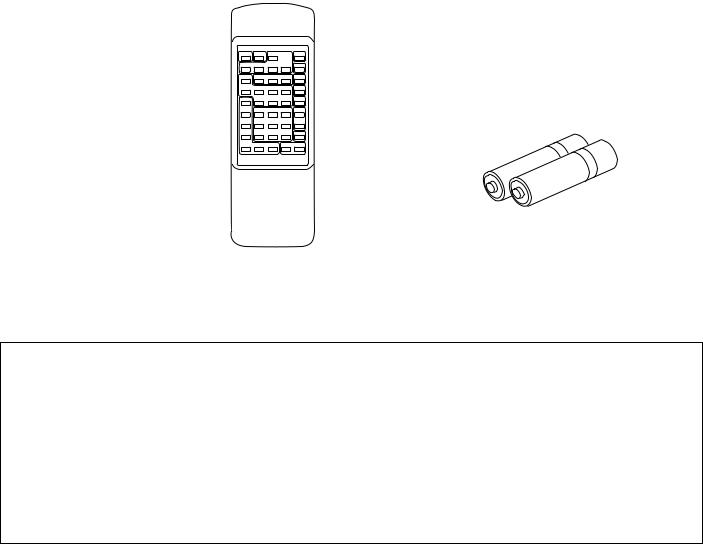
SUPPLIED ACCESSORIES ACCESSOIRES FOURNIS MITGELIEFERTE ZUBEHORTEILE MEDFOLJANDE TILLBEHOR ACCESSORI IN DOTAZIONE ACCESORIOS INCLUIDOS BIJGELEVERDE ACCESSOIRES
●After unpacking, check that the following parts are included.
●Après le déballage, vérifier que les pièces suivantes sont incluses.
●Nach dem Auspacken überprüfen, ob die folgenden Teile vorhanden sind.
●Kontrollera efter det apparaten packats upp att följande delar finns med.
●Verificare che tutte le parti seguenti siano contenute nell’imballaggio dell’apparecchio.
●Desembale el aparato y verificar que los siguientes accesorios están en la caja.
●Controleer na het uitpakken of de volgende onderdelen voorhanden zijn.
● |
Remote Control Transmitter |
● |
Batteries (size AA, R6, UM-3) |
● |
Emetteur de télécommande |
● |
Piles (taille AA, R6, UM-3) |
● |
Fernbedienungsgeber |
● |
Batterien (Größe AA, R6, UM-3) |
● |
Fjärrkontrollsändare |
● |
Batterier (storlek AA, R6, UM-3) |
● |
Telecomando |
● |
Batterie (dimensioni AA, R6, UM-3) |
● |
Transmisor del control remoto |
● |
Pilas (tamaño AA, R6, UM-3) |
● |
Afstandbediening |
● |
Batterijen (maat AA, R6, UM-3) |
|
|
|
|
This product complies with the radio frequency interference requirements of the Council Directive 82/499/EEC and/or 87/308/EEC.
Cet appareil est conforme aux prescriptions de la directive communautaire 87/308/CEE.
Diese Geräte entsprechen der EG-Richtlinie 82/499/EWG und/oder 87/308/EWG.
Dette apparat overholder det gaeldende EF-direktiv vedrørende radiostøj.
Questo apparecchio è conforme al D.M.13 aprile 1989 (Direttiva CEE/87/308) sulla soppressione dei radiodisturbi.
Este producto está de acuerdo con los requisitos sobre interferencias de radio frecuencia fijados por el Consejo Directivo 87/308 CEE.
Dit product voldoet aan de EEG normen betreffende radio-frekwentie storingen 82/499/EEG en/of 87/308/EEG.
2

Thank you for selecting this YAMAHA digital sound field processing amplifier.
FEATURES
●5 Speaker Configuration
Front: 70W + 70W (8Ω ) RMS Output
Power, 0.04% THD, 20–20,000 Hz Center: 70W (8Ω ) RMS Output Power,
0,07% THD, 20–20,000 Hz Rear: 20W + 20W (8Ω ) RMS Output
Power, 0.3% THD, 1 kHz
●Digital Sound Field Processor
6 Programs for Digital Sound Field Processing
2 Programs for Dolby Surround Decoding (DOLBY PRO LOGIC and DOLBY PRO LOGIC ENHANCED)
●Automatic Input Balance Control for Dolby Surround
●Test Tone Generator for Easier Speaker Output Balance Adjustment
●3 Center Channel Modes (NORMAL/WIDE/PHANTOM)
●Video Signal Input/Output Capability (Including S Video Connections)
●SLEEP Timer
●Remote Control Capability
CONTENTS
Supplied Accessories ...................................... |
2 |
Caution ............................................................ |
4 |
Profile of This Unit ........................................... |
5 |
Speaker Setup for This Unit ............................ |
6 |
Connections .................................................... |
7 |
Speaker Balance Adjustment ........................ |
12 |
Basic Operations ........................................... |
15 |
Using Digital Sound Field Processor (DSP) .. |
18 |
Setting the SLEEP Timer .............................. |
22 |
Remote Control Transmitter .......................... |
23 |
Notes about the Remote Control Transmitter |
|
....................................................................... |
24 |
Troubleshooting ............................................. |
25 |
Specifications ................................................ |
26 |
English
3
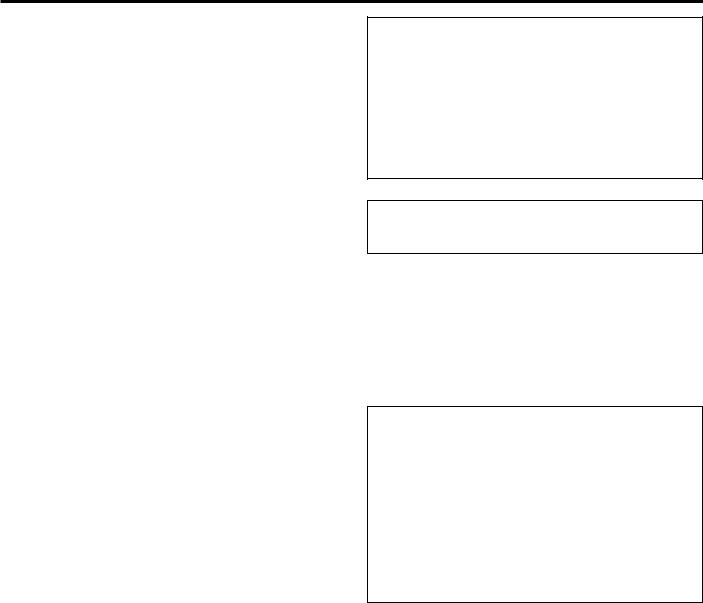
CAUTION : READ THIS BEFORE OPERATING YOUR UNIT.
1.To assure the finest performance, please read this manual carefully. Keep it in a safe place for future reference.
2.Install this unit in a cool, dry, clean place – away from windows, heat sources, sources of excessive vibration, dust, moisture and cold. Avoid sources of humming (transformers, motors). To prevent fire or electrical shock, do not expose the unit to rain or water.
3.Never open the cabinet. If something drops into the set, contact your dealer.
4.Do not use force on switches, controls or connection wires. When moving the unit, first disconnect the power plug and the wires connected to other equipment. Never pull the wires themselves.
5.The openings on the cabinet assure proper ventilation of the unit. If these openings are obstructed, the temperature inside the cabinet will rise rapidly and eventually damage the circuits. Therefore, avoid placing objects against these openings and do not install the unit where the flow of air through the ventilation openings could be impeded.
6.Always set the VOLUME control to “–∞ ” before starting the audio source play. Increase the volume gradually to an appropriate level after playback has been started.
7.Do not attempt to clean the unit with chemical solvents; this might damage the finish. Use a clean, dry cloth.
8.Be sure to read the “TROUBLESHOOTING” section regarding common operating errors before concluding that the unit is faulty.
9.When not planning to use this unit for long periods of time (ie., vacation, etc.), disconnect the AC power plug from the wall outlet.
10.To prevent lightning damage, disconnect the AC power plug and disconnect the antenna cable when there is an electrical storm.
11.Grounding or polarization – Precautions should be taken so that the grounding or polarization of an appliance is not defeated.
12.AC outlet
Do not connect audio equipment to the AC outlet on the rear panel if that equipment requires more power than the outlet is rated to provide.
13.Voltage Selector (General Model only)
The voltage selector on the rear panel of this unit must be set for your local main voltage BEFORE plugging into the AC main supply.
Voltages are 110/120/220/240V AC, 50/60 Hz.
IMPORTANT
Please record the serial number of this unit in the space below.
Serial No.:
The serial number is located on the rear of the unit.
Retain this Owner’s Manual in a safe place for future reference.
WARNING
TO REDUCE THE RISK OF FIRE OR ELECTRIC SHOCK, DO NOT EXPOSE THIS UNIT TO RAIN OR MOISTURE.
The apparatus is not disconnected from the AC power source as long as it is connected to the wall outlet, even if the apparatus itself is turned off.
For U.K. customers
If the socket outlets in the home are not suitable for the plug supplied with this appliance, it should be cut off and an appropriate 3 pin plug fitted. For details, refer to the instructions described below.
Note: The plug severed from the mains lead must be destroyed, as a plug with bared flexible cord is hazardous if engaged in a live socket outlet.
Special Instructions for U.K. Model
IMPORTANT
THE WIRES IN THE MAINS LEAD ARE COLOURED IN ACCORDANCE WITH THE FOLLOWING CODE:
Blue: NEUTRAL
Brown: LIVE
As the colours of the wires in the main lead of this apparatus may not correspond with the coloured markings identifying the terminals in your plug, proceed as follows:
The wire which is coloured BLUE must be connected to the terminal which is marked with the letter N or coloured BLACK. The wire which is coloured BROWN must be connected to the terminal which is marked with the letter L or coloured RED. Make sure that neither core is connected to the earth terminal of the three pin plug.
4
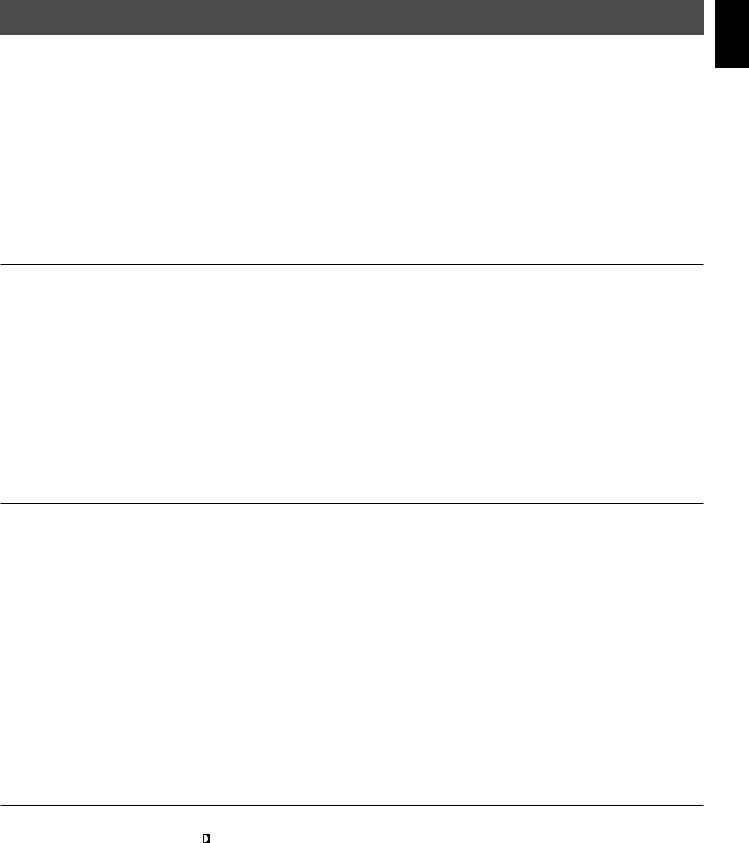
PROFILE OF THIS UNIT
You are the proud owner of a Yamaha stereo amplifier –an extremely sophisticated audio component. The Digital Sound Field Processor (DSP) built into this unit takes full advantage of Yamaha’s undisputed leadership in the field of digital audio processing to bring you a whole new world of listening experiences. Follow the instructions in this manual carefully when setting up your system, and this unit will sonically transform your room into a wide range of listening environments –movie theater, concert hall, and so on. In addition, you get incredible realism from Dolby-encoded video sources using the built-in Dolby Pro Logic Surround Decoder. Please read this operation manual carefully and store it in a safe place for later reference.
English
Digital Sound Field Processing
What is it that makes live music so good? Today’s advanced sound reproduction technology lets you get extremely close to the sound of a live performance, but chances are you’ll still notice something missing: the acoustic environment of the live concert hall. Extensive research into the exact nature of the sonic reflections that create the ambience of a large hall has made it possible for Yamaha engineers to bring you this same sound in your own listening room, so you’ll feel all the sound of a live concert.
What’s more, our technicians, armed with sophisticated measuring equipment, have even made it possible to capture the acoustics of a variety of venues such as an actual concert hall, theater, etc. to allow you to accurately recreate one of several actual live performance environments, all in your own home.
Dolby Pro Logic Surround
The Dolby Pro Logic Surround Decoder program lets you experience the dramatic realism and impact of Dolby Surround movie theater sound in your own home. Dolby Pro Logic gets its name from its professional-grade steering logic circuitry, which provides greater effective front and rear channel separation for a much higher degree of realism than the “passive” Dolby Surround circuits found in less sophisticated home audio/video equipment. Dolby Pro Logic Surround provides a true center channel, so that there are four independent channels, unlike passive Dolby Surround which has in effect only three channels: left, right, and rear. This center channel allows listeners seated in even less-than-ideal positions to hear the dialog originating from action on the
screen while getting a stereo effect as well.
Dolby Pro Logic Surround + DSP
You can also enjoy a combination of Dolby Pro Logic Surround and DSP in the sound field program “  PRO LOGIC ENHANCED”.
PRO LOGIC ENHANCED”.
It recreates the surround effect of a movie theater, effectively duplicating its multiple surround loudspeaker system, completely surrounding the listener with the sounds of the action taking place on the screen.
5
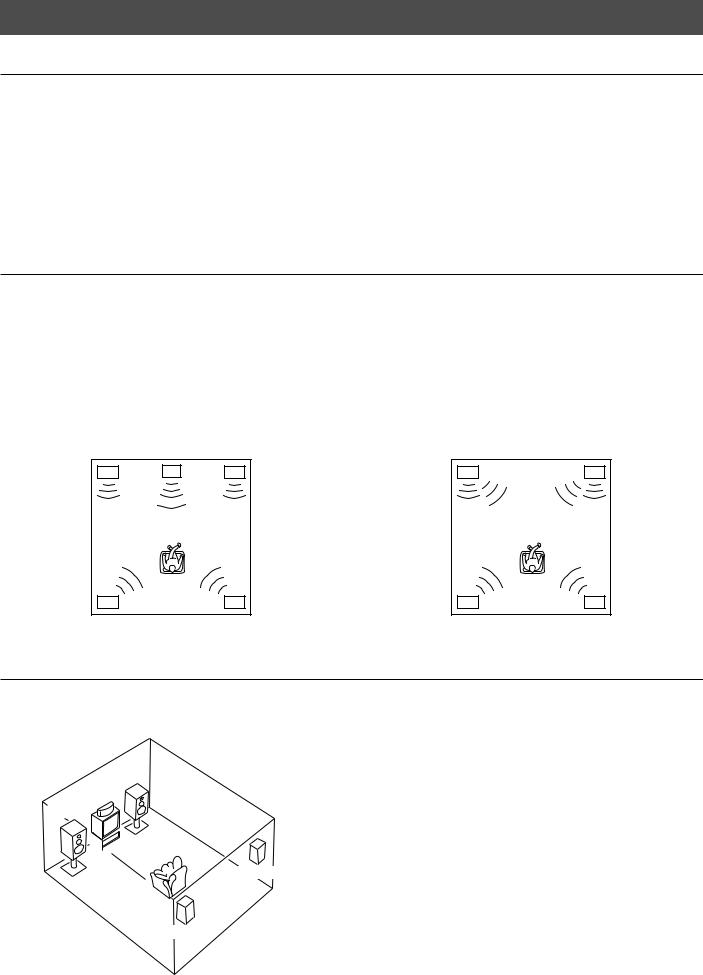
SPEAKER SETUP FOR THIS UNIT
SPEAKERS TO BE USED
This unit is designed to provide the best sound-field quality with a 5 speaker configuration. The speakers to be used with this unit will be mainly front speakers, rear speakers, and a center speaker. (You can omit the center speaker. Refer to the “4-Speaker Configuration” shown below.)
The front speakers are used for the main source sound and the effect sound. They will probably be the speakers of your present stereo speaker system. The rear speakers are used for the effect sound. And the center speaker is used for the center sound (dialog etc.) encoded with the Dolby Surround. The rear and center speakers do not need to be equal in power to the front speakers. However, all the speakers should have high enough power handling to accept the maximum output of this unit.
SPEAKER CONFIGURATION
5-Speaker Configuration
This configuration is the most effective and recommended one. In this configuration, the center speaker is necessary as well as the rear speakers. If the digital sound field program DOLBY PRO LOGIC or DOLBY PRO LOGIC ENHANCED is selected, conversations will be output from the center speaker and the ambience will be excellent.
●Set the center channel mode to the “NORMAL” or “WIDE” position. (For details, refer to page 13.)
Front L |
Center |
Front R |
Dialogue
4-Speaker Configuration
The center speaker is not used in this configuration. If the digital sound field program DOLBY PRO LOGIC or DOLBY PRO LOGIC ENHANCED is selected, the center sound is output from the left and the right front speakers. However, the sound effect of other programs can be the same as that of the 5-speaker configuration.
●Be sure to set the center channel mode to the “PHANTOM” position. (For details, refer to page 13.)
Front L |
Front R |
Dialogue
Surround sound |
Surround sound |
||
Rear L |
Rear R |
Rear L |
Rear R |
SPEAKER PLACEMENT
The recommended speaker configuration, the 5-speaker configuration, will require two speaker pairs: front speakers (your normal stereo speakers), and rear speakers, plus a center speaker. When you place these speakers, refer to the following.
Front R
Center
Front L
 TV set
TV set
Rear R
Front: In normal position. (The position of your present stereo speaker system.)
Rear: Behind your listening position, facing slightly inward. Nearly six feet (approx. 1.8 m) up from the floor.
Center: Precisely between the front speakers. (To avoid interference with TV sets, use a magnetically shielded speaker.)
Rear L
6
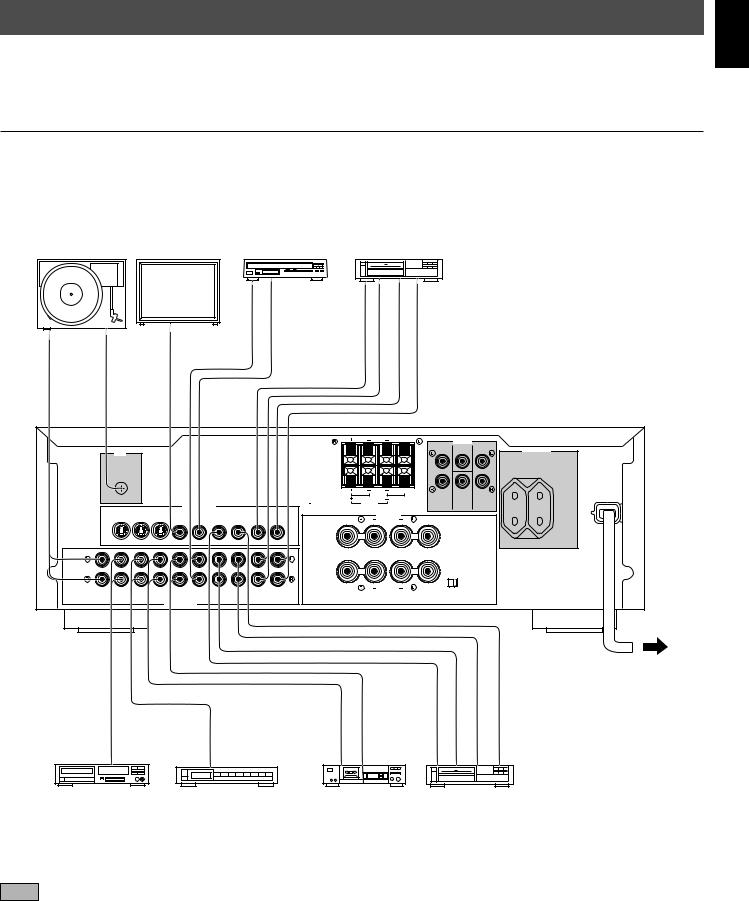
CONNECTIONS
Before attempting to make any connections to or from this unit, be sure to first switch OFF the power to this unit and to any other components to which connections are being made.
CONNECTIONS WITH OTHER COMPONENTS
When making connections between this unit and other components, be sure all connections are made correctly, that is to say L (left) to L, R (right) to R, “+” to “+” and “–” to “–”. Also, refer to the owner’s manual for each component to be connected to this unit.
English
|
|
|
|
LD player, |
|
|
|
|
|
Turntable |
Monitor TV |
|
TV tuner, etc. |
Video cassette recorder 2 |
|||
OUTPUT |
GND |
VIDEO IN |
AUDIO OUT |
VIDEO OUT |
VIDEO OUT |
AUDIO OUT |
VIDEO IN |
AUDIO IN |
(Europe model)
|
|
|
|
|
|
|
|
|
|
8ΩMIN. |
|
|
|
OUTPUT |
|
|
|
|
|
|
|
|
|
|
|
|
/SPEAKER |
|
|
FRONT |
REAR |
AC OUTLETS |
|
|
GND |
|
|
|
|
|
|
|
|
|
REAR |
|
|
|
|
|
|
|
|
|
|
|
|
|
|
|
|
|
|
|
|
|
|
|
|
|
|
|
|
|
|
|
|
|
|
|
|
|
|
SWITCHED |
|
|
|
|
|
|
|
|
|
|
|
|
|
|
|
|
l20W MAX. TOTAL |
|
|
|
|
|
|
|
|
|
|
|
CENTER |
|
|
|
|
|
|
|
|
|
|
|
|
|
|
|
|
|
C |
D |
|
|
|
|
|
|
|
|
|
|
|
|
|
|
|
|
DUAL |
|
LOW |
MAINS |
|
|
|
|
|
VIDEO SIGNAL |
|
|
|
C |
D:4ΩMIN./SPEAKER |
SINGLE |
|
PASS |
|
||
|
8 VIDEO |
|
|
|
|
|
SINGLE:8ΩMIN./SPEAKER |
SPEAKERS |
|
fc:200Hz |
|
|||||
|
|
|
|
VCR 1 |
|
|
|
|
||||||||
|
MONITOR |
VCR 2 |
|
MONITOR |
LD/TV |
IN |
IN |
VCR 2 |
|
|
SPEAKERS |
|
|
|
||
|
OUT |
IN |
OUT |
|
OUT |
|
OUT |
OUT |
|
|
|
|
|
|
||
|
|
|
|
|
|
|
|
|
|
|
A |
|
|
A |
|
|
|
|
|
|
|
|
|
|
|
|
|
|
|
|
|
A OR B:8ΩMIN. |
|
|
|
|
|
|
|
|
|
|
|
|
|
|
|
|
/SPEAKER |
|
|
|
|
|
|
|
|
|
|
|
|
|
|
|
|
A B:l6ΩMIN. |
|
|
|
|
|
|
|
|
|
|
|
|
|
|
|
|
/SPEAKER |
|
|
|
|
|
|
|
|
|
|
|
|
B |
|
|
B |
|
|
|
|
|
TAPE |
REC |
|
IN |
OUT |
IN |
OUT |
|
|
|
-l0 dB |
0 dB |
|
|
|
|
|
PB |
|
OUT |
|
|
|
FRONT |
FRONT |
|
|||||
PHONO |
CD |
TUNER |
|
TAPE |
LD/TV |
|
VCR 1 |
|
VCR 2 |
|
|
|
||||
|
|
|
|
|
|
LEVEL |
|
|||||||||
|
|
|
|
AUDIO SIGNAL |
|
|
|
|
|
|
|
|
|
|
||
To AC outlet
OUTPUT |
OUTPUT |
LINE OUT |
LINE IN |
VIDEO OUT |
AUDIO OUT |
AUDIO IN |
VIDEO IN |
CD player |
Tuner |
|
Tape deck |
Video cassette recorder 1 |
|||
: Refer to “ABOUT THE ACCESSORY TERMINALS” on page 11.
7
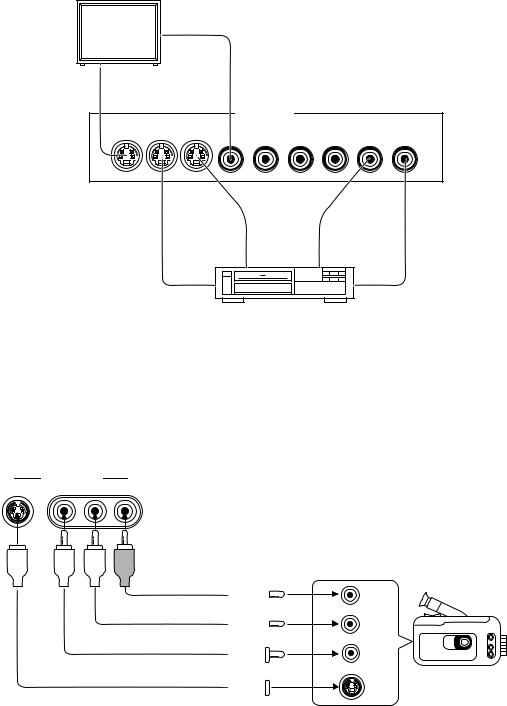
CONNECTING TO S VIDEO TERMINALS
If you have a video cassette recorder and a monitor equipped with “S” (high-resolution) video terminals, those terminals can be connected to this unit’s S VIDEO terminals. Connect the video cassette recorder’s “S” video input and output terminals to this unit’s S VIDEO VCR 2 IN and OUT terminals respectively, and connect the monitor’s “S” video input terminal to this unit’sS VIDEO MONITOR OUT terminal. Otherwise, connect the video cassette recorder’s composite video terminals to this unit’s composite video terminals, and connect the monitor’s composite video input terminal to this unit’s composite MONITOR OUT terminal.
Note
If video signals are sent to both S VIDEO input and composite input terminals, the signals will be sent to their respective output terminals independently.
|
Monitor TV |
|
|
|
|
|
|
|
|
|
|
|
VIDEO |
|
|
|
|
|
|
|
|
|
IN |
|
|
|
|
|
|
VIDEO |
IN |
|
|
VIDEO SIGNAL |
|
|
|
|
|
S |
S VIDEO |
|
|
|
|
||||
MONITOR |
LD/TV |
|
VCR 1 |
|
VCR 2 |
||||
|
MONITOR |
IN |
VCR 2 |
IN |
IN |
||||
|
OUT |
OUT |
OUT |
|
OUT |
OUT |
|||
|
S VIDEO |
OUT |
|
S VIDEO IN |
|
|
VIDEO OUT |
|
VIDEO IN |
Video cassette recorder 2
CONNECTING TO VIDEO AUX TERMINALS (ON THE FRONT PANEL)
These terminals are used to connect any video input source such as a camcorder to this unit.
VIDEO AUX
S VIDEO |
VIDEO |
L AUDIO R |
AUDIO OUT R  AUDIO OUT L
AUDIO OUT L VIDEO OUT
VIDEO OUT
S VIDEO OUT
R
L
VIDEO
Camcorder
S VIDEO
8
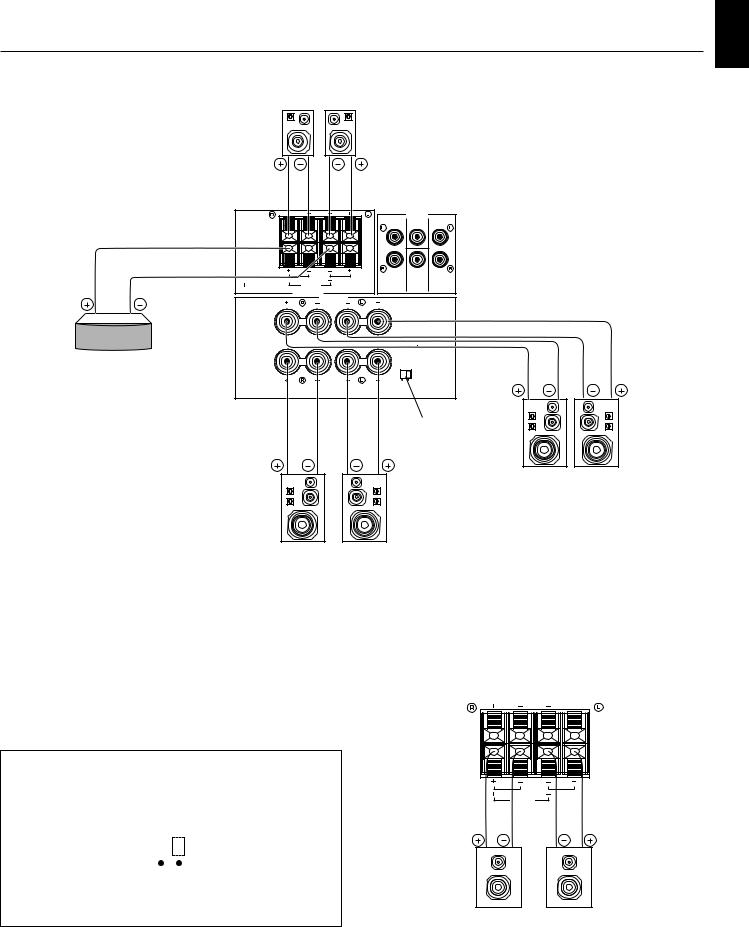
CONNECTING SPEAKERS
Connect the respective speakers to this unit as figured below.
Rear speakers
Right |
Left |
English
8ΩMIN. |
|
|
OUTPUT |
|
/SPEAKER |
|
FRONT |
REAR |
|
|
REAR |
|
|
|
|
CENTER |
|
|
|
|
|
C |
D |
|
|
|
DUAL |
|
LOW |
C |
D:4ΩMIN./SPEAKER |
SINGLE |
|
PASS |
|
fc:200Hz |
|||
SINGLE:8ΩMIN./SPEAKER SPEAKERS |
|
|||
|
|
|||
|
|
SPEAKERS |
|
|
|
A |
|
A |
|
|
A OR B:8ΩMIN. |
|
|
/SPEAKER |
|
|
A B:l6ΩMIN. |
|
|
/SPEAKER |
|
B |
B |
|
Center speaker |
|
|
|
-l0 dB 0 dB |
|
FRONT |
FRONT |
|
|
LEVEL |
|
|
Right |
Left |
|
FRONT LEVEL |
|
|
switch |
|
|
(U.K., Europe and |
|
|
Australia models) |
|
Right |
Left |
Front speakers A |
Front speakers B
Note on front speaker connection:
One or two speaker systems can be connected to this unit. If you connect only one speaker system, connect it to either the SPEAKERS A or B terminals.
Note on center speaker connection:
One or two center speakers can be connected to this unit. If you cannot place the center speaker on or under the TV, it is recommended to use two center speakers and place them on both sides of the TV to orient the center sound at the center position. For connecting two center speakers, follow the method shown below.
|
REAR |
|
FRONT LEVEL switch |
CENTER |
|
|
|
|
<U.K., Europe and Australia models only> |
C |
D |
Normally set to “0 dB”. If desired, you can decrease the |
|
DUAL |
|
SINGLE |
|
output level at the FRONT SPEAKERS terminals by 10 dB by |
|
|
|
|
|
setting this switch to “–10 dB”. |
|
|
|
|
|
|
|
|
|
|
|
|
|
|
l |
l0 dB 0 dB |
||||
FRONT
LEVEL
Center speaker |
Center speaker |
9
